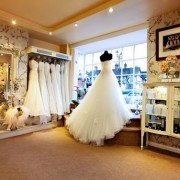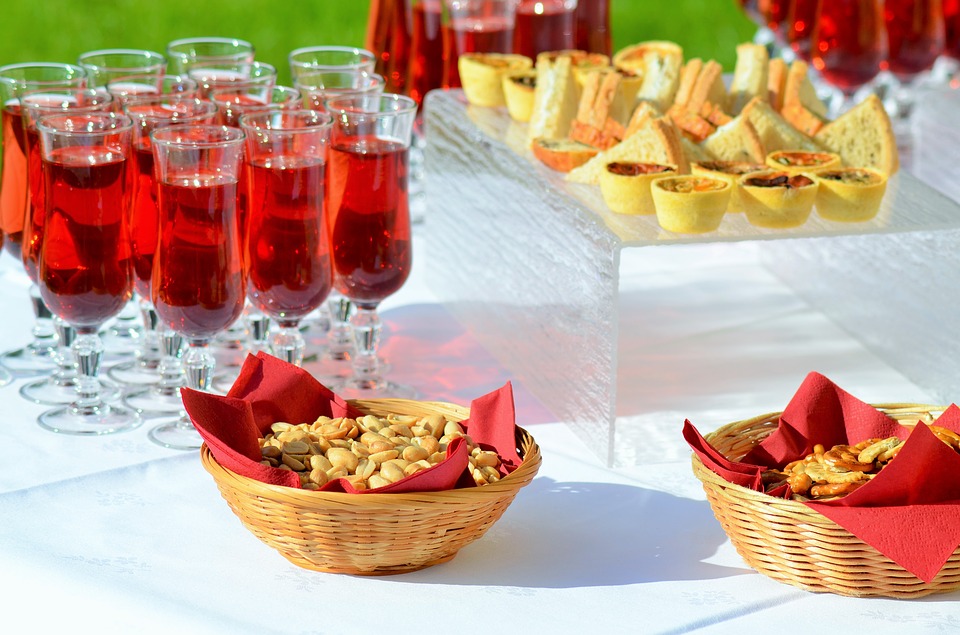Choosing Your Wedding Reception Food: Plated, Buffet or Something Else?
There’s no question that, when planning for your wedding, the food will be the biggest expense. You can expect to spend 45-50% of your entire wedding budget just on food! However, it is essential to feed your wedding guests appropriately and as well as you can. Your reception meal is also significant because it’s the very first meal you’ll share as husband and wife!
Deciding on which type of meal to serve can be a challenge, so here’s a review of the 3 most typical wedding reception serving styles, plus a couple of other choices you might want to consider.
An Overview
Unless you’re planning either just cake and punch or some type of light snacks for your wedding reception refreshments, you’ll find yourself choosing from three major types of dinner service. Plated meals, buffets, and family style are each traditional in their own right, with plated meals usually considered the most expensive, buffets less costly, and family style falling somewhere in the middle.
However, that ranking doesn’t necessarily hold. It all depends on where you live and what menu options you have. In addition, each style has its own ways of either making the most of your wedding budget or draining it completely. You also have to take into consideration cultural traditions and the expectations of your family and guests.
So let’s take a closer look at those three major serving styles for wedding reception food and the advantages and disadvantages of each, not just monetary but also how each style is commonly viewed by wedding guests based on your particular social circle as well as your venue.
Formal Plated Wedding Reception
Plated dinners are so traditional that Emily Post devoted an entire section about sit-down—now known as plated—wedding breakfasts when she wrote her 1922 Etiquette book!
-
Plated meals are individual dinners
Though you probably already know, for clarification, with a plated dinner, every guest sits and is served a single meal—on a plate—by your caterer’s waitstaff. Depending on the venue, you can select from preset menu choices or do a little mix and match based on their standard options.
-
Guests are served their preselected RSVP choice
Sometimes the serving staff is given a copy of the seating chart, so they know how many guests at that table pre-ordered chicken and how many ordered fish, or whatever your second selection is, based on your RSVP cards. Other times, you just give the caterer a count of how many of each entree to prepare, then the waitstaff asks each guest, “Did you order chicken or fish?” and serves the appropriate plate.
-
The number of courses may vary
It’s common, just like with a restaurant meal, to offer a salad, an entree that includes a vegetable and often a potato or rice, and a dessert. The dessert can be wedding cake or another selection. As a general rule, a basket of dinner rolls or another bread comes with the meal, and you also might have the option to have a crudité plate (raw vegetables and pickles). Just as with any formal banquet, the fancier your venue, the more courses you can add.
And just for fun, did you know passengers on the Titanic were served an eleven-course meal? That’s way over the top, but we thought you might like a rundown of the classic 7-course dinner to give you some ideas:
A Classic 7-Course Dinner
- Cold or hot hors d’oeuvre or appetizer
- Soup
- Salad or a Fish or shellfish item
- Palate cleanser (the most common is lemon sorbet)
- Fish or poultry
- Red meat, fish or poultry with vegetables
- Hot or cold dessert
Pro’s & Con’s
Most likely the biggest plus is that a plated dinner is considered “classy.” While it’s perfect for both intimate and formal receptions, it’s also “expected” depending on your demographic or social circle. Here are other considerations:
Advantages of a Plated Wedding Reception Dinner
- Guests feel pampered
- Reduced chance of spilled plates
- Consistent serving time between courses
- Guests can focus on conversation or the wedding program
- Control over portion size
- Control over the cost of each menu item
- Guaranteed one full dinner per guest
- Good option for both intimate & formal gatherings
Disadvantages of a Plated Wedding Reception Dinner
- Some guests may feel underfed
- Some guests may not like the limited choices
- Some guests might not like the choices at all
- Food allergies may be a concern
- Response cards are required (unless you select only one entree for everyone)
- Escort & place cards may be necessary (so servers can track who gets what)
- Limited food options (unless you can pay more and serve a la carte items)
- More servers required
Biggest downside: Cost
Depending on where you live, you could pay anywhere from $20 up to $100 for each dinner. That’s per person, so multiply by just 100 guests and you’re looking at $2,000 to $10,000. That is a serious investment!
And there’s more “good” news: You pay for all no-shows. Whatever final headcount you give the caterer a few days before the wedding, that’s it. And if you have a few more people show up, you’ll be asked to pay the extra, often that night. It’s not uncommon for a bill to be presented to the responsible party sometime after dinner is served and the tables cleared—and you have to pay right then unless prior arrangements have been made.
Buffet Wedding Reception
Buffets are typically set up on long tables with lines on either side so that guests can help themselves. There’s a lovely trend lately of jazzing up buffets with carving blocks or cooking stations. Picky eaters especially love buffets since they’re bound to find something they like. You’ll have to be careful in how you set up the serving tables, though, in order to avoid guests standing in long and confusing lines.
Possibly the biggest issue with a buffet for your wedding is the expectation of the level of formality on the part of your guests. Again, it all depends on your demographic and social circle, but sometimes a buffet may be frowned upon.
Advantages of a Buffet Wedding Reception Dinner
- Guests serve themselves, so they get what they want
- Guests eat exactly how much they want
- More menu item choices
- Fewer issues with food allergies or picky eaters
- Guests can mingle in line
- No need for RSVP meal cards
- Fewer servers needed
- Lower cost due to less expensive presentation
Disadvantages of a Buffet Wedding Reception Dinner
- Increased chance of spilled plates
- Some guests may overeat, therefore…
- Some guests may feel underfed
- Possibility of running out before everyone is served
- First in line finishes eating before the last in line gets their food
- Interruption in the wedding program if guests go back for seconds
- Keeping food warm and cold respectively
- Concerns about safe navigation (small children and elderly)
- Sometimes viewed as “low class”
- Sometimes seen as an “upscale cafeteria”
Questionable consideration: Cost
Again, depending on where you live, a buffet could still run close to the same price range as a plated dinner. You probably won’t pay less than $20 per person, but you might find something for no more than $50-60 depending. You’ll still pay for no-shows in that you might have food left over and not all caterers let you have the leftovers.
Part of the lesser cost involves the fact that when it comes to presentation, you’ll pay significantly less for a buffet with chafing dishes than for individual plate presentation or the platters involved in a family style service.
However, if you have the right location, the right venue and caterer, and the right crowd, and especially if you’re having a casual DIY wedding, opting for a buffet can save you some serious cash and make your wedding a lot of fun.
DIY Tip: The trick to making a buffet beautiful is to use what caterers call “lifts and levels.” Check out this link for a tutorial: http://www.homegoods.com/blog/2013/11/22/holiday-buffet-tables-rise-to-the-occasion/
Family Style Wedding Reception
Family style is an interesting option that hinges on the key phrase “it depends.” It’s definitely geared toward a friendlier crowd because it’s exactly how it sounds—platters of food set at each table that you pass from person to person, just like at a family dinner table.
The “it depends” factor is multi-fold. Whether or not family style will work for your wedding depends on your crowd—it depends on your budget—it depends on the mood you want to set—it depends on whether you want fancier table arrangements or none at all. Also, each table is a little family, which may or may not work so well if you have too many on your guest list who tend to be very shy or standoffish.
The advantages and disadvantages are similar to a buffet, mostly because each person serves himself, but it’s a bit less hectic because people don’t have to get up from the table.
When it comes to price, family style often falls somewhere between plated dinners and buffets, but sometimes costs more. You never know, so just ask your caterer.
As for food items, sometimes the caterer will have set menu groups like you’ll find with plated dinners, and sometimes you can pick from a broader selection like you would with a buffet.
“It all depends.”
Advantages of a Family Style Wedding Reception Dinner
- Family style truly represents two families coming together
- Guests serve themselves, so they get what they want
- Guests eat how much or little they want
- Ease of service for children and light eaters
- Guests can interact at the table
- No need for RSVP meal choice cards
- Fewer servers usually required
- Sometimes lower cost due to less expensive presentation
- If using larger tables, you’ll need fewer tables
- Fewer waitstaff needed than a plated meal
Disadvantages of a Family Style Wedding Reception Dinner
- Increased chance of spilled plates
- No control over portions (first to handle the platter may take more)
- Some guests may overeat, therefore…
- Some guests may feel underfed
- Possibility of running out before everyone is served
- Sometimes viewed as “low class”
- Some guests may not like a platter “crowding their elbow”
- If using larger tables, there may be more expense for linens
- More waitstaff than a buffet dinner
- Might have to remove or eliminate centerpieces
Regarding that last item—remove or eliminate centerpieces—you may find that to be a benefit because you won’t have room for fancier, more expensive table decorations. You might even be able to skip centerpieces altogether.
Be aware that larger tables may require more linens which might cost you more, and you might need to consider a larger venue space as well. Also, not only may you have added rental costs, but you’ll need to factor in more waitstaff than you would for a buffet.
Inventive Option #1: Cocktail Parties & Food Stations
Cocktail parties are a classic standard, and most caterers have hors d’oeuvres packages for you to choose from. It’s relatively simple: Just have some kind of bar service (usually an open bar since you’re not serving dinner) and then appetizers only. If you do a little research into the concept of “heavy hors d’oeuvres” vs. a “cocktail hour,” the only main difference is the food offered. “Heavy” reception menu items are a bit more hearty and sometimes there’s more quantity.
You can ramp the formality up or down depending, having waitstaff circulate with trays, or set up a table of hors d’oeuvres buffet-style for guests to help themselves. Obviously having circulating waitstaff will cost more, but you can get away with less food because people expect to nibble, not eat.
A more casual take on a cocktail party that’s a cross between a buffet and heavy hors d’oeuvres is a food station reception. You can have anything from small pizzas to make your own s’mores or grilled cheese. Food stations are considered “fun” and so they definitely work better with a lighthearted crowd.
For some really great ideas for food stations check out this blog: https://www.weddingsonline.ie/blog/wedding-food-stations-your-guests-will-love/
Inventive Option #2: Restaurant Menu
A very classy choice—but usually suited to a smaller guest list—is a restaurant reception. You can order set dinners like a plated reception or, if your group is reasonably small, you can let your guests order individually off the menu. Some restaurants can accommodate a good sized crowd, so just check the prices and see what’s more cost-effective—plates or ala carte.
Possibly the two biggest perks to a restaurant reception are more menu and drink choices and more personalized service. Restaurant staff can also hold entrees to slow things down to allow for some people eating slower than others.
One more advantage of a restaurant reception is that if your families want to share the cost of the party, it’s easy to split the tab into drinks, entrees, and appetizers/desserts. This can be a good option if you and your fiancé want to pay part and one or both of your parents want to pitch in.
Sometimes the restaurant has its own pastry chef so do make sure to double check restrictions if you think you want to bring in an outside wedding cake.
Making the Final Decision
Here’s a little checklist along with some more ideas to help you sort out your various options:
- Match the formality of the meal to the venue.
- Meet the expectations of both sides of the family.
- Considering splitting the costs, maybe 3 ways.
- Serve wine, beer, and two signature drinks rather than an open bar.
- Limiting your guest list will decrease the bill.
- Don’t offer a soup course at a formal dinner.
- Skip extra desserts & let the wedding cake be enough.
- Don’t have passed hors d’oeuvres—either set up stations or skip appetizers altogether.
- Choose less costly menu items, specifically meats.
- Consider the season: Some food items cost more at certain times of the year.
- Skip the champagne toast—let guests toast with whatever drink they have in their hand.
Whatever meal service you choose, make sure it’s appropriate to the ambiance of your wedding. If you want a more formal vibe, a plated dinner or upscale cocktail party may be good choices. If you want your wedding to be more casual, then a buffet or food stations might be your best bet.
When it comes right down to it, though, it’s your big day and truly? Your guests should be happy just to see you get married!
And because we can’t resist a little fun to close, here’s a link for that eleven-course meal served on the Titanic: https://en.wikipedia.org/wiki/Full_course_dinner#Example_meal










Recent Comments